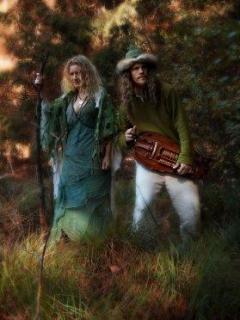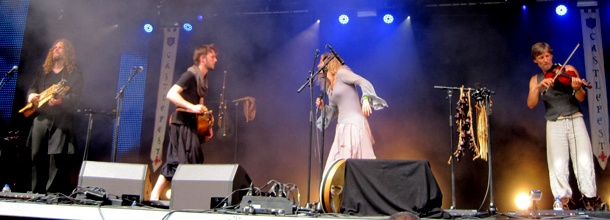On the Danish band Asynje, on finding inspiration in dusty old manuscripts, and on modern Viking romanticism.
It is night. In Denmark's National Museum, in the middle of old Copenhagen, the over two hundred year-old entrance hall is full of people listening to the Danish band Asynje, playing their debut concert on Copenhagen's Night of Culture. Asynje play a fascinating array of acoustic medieval instruments and modern electronic sound and rhythm apparatus, overlaid by a female voice singing alluring ballads about Vikings and their gods, from the period between the years 600 and 1050 A.D.
The Band
The band comprises four musicians who play all over Denmark and Europe, at music venues, festivals and Viking markets. They are: Nana Barslev (vocal, percussion), Martin Seeberg (violin, flute, lyre), Søren Hammarlund (hurdy-gurdy, keyed fiddle, electronics) and Troels Dueholm Nørgaard (whistles, hurdy-gurdy and octave mandolin).
Asynje are in close contact with a wide and noticeably youthful audience who are fascinated by ancient Nordic mythology and its universe of the gods and goddesses. I asked Søren Hammerlund how much we actually know about the music the Vikings played.
“Nothing. Nothing whatsoever! But we have some instruments from that time, and we have various sources that describe the music, so we can build up a picture of how it may have sounded. But Asynje does not play the music the way it may have sounded back then, that is not our aim at all. It is more about connecting with our own culture and being inspired by it.”
Asynje starts as a duo, but then the concept expands when the National Museum in Copenhagen propose a special concert experience for the Museum's visitors. The Museum want a musical setting for Nordic history, in particular a modern take on the Viking era, in order to appeal to a broader audience. Since the concert at the National Museum, momentum has been gathering, with concerts in Denmark, Germany, Holland and Belgium.
Painting Music
Wherever the band play, critics and audience alike remark on Asynje's ability to give the Nordic scenery and mythology a setting in sound and pictures. “You are seized by the urge to grab crayons and draw waves, the sea, and steep mountainsides,” as one Belgian journalist writes, and that proves to be one of the aspects that makes Asynje's music special: their knack of letting the music paint pictures in their listeners' minds.
“What we are investigating with our music is the beautiful and dramatic Scandinavian countryside as a setting for new and ancient Nordic legends,” says Søren Hammerlund, and continues: “I think we find about half of our material in old books and manuscripts in the dustiest corners of old libraries, for instance Poetic Edda (Den Ældre Edda), and then we put it to music. The rest we write ourselves.”
The Poetic Edda Søren is talking about is a collection of poetry from Nordic mythology and the Nordic sagas. Written in Iceland in medieval times, the poems are several hundred years older, and were handed down since Viking times in an oral tradition. That is one of the texts that have inspired Asynje, and it influenced the band's first album, from 2012.

On Asynje's debut album we find songs and tunes like The Giants of Dovre Mountain (Kjæmperne på Dovrefjeld), Viking Party Polka, Njord & Skade (two Nordic goddesses), and The Knife Polska (Knivens Polska). I asked Hammarlund how the band work with the songs.
“Any of us can propose a new number in Asynje, but when I am working on a new song, I might start with an old book, perhaps a fragment of song, and a scrap of a tune. But it is not complete yet, because there is no story, maybe just a picture or an idea. The bits of tunes have to be assembled, I have to see how I can develop them. Sometimes I compose something, or research old contemporary sources to find a piece I can add on to what I already have. It is the same with the words. I check on the historical period, to see what images I can use while converting the poem into a song. That is one method we use. Another is to begin with an electronic beat that Nanna sings to. That way, we find inspiration by using ancient frames from the Danish or Nordic traditions.
Vikings and Romanticism
While interviewing Søren Hammarlund, I recall my own childhood fascination with the Vikings and their amazing tales of hazardous sea voyages of discovery, foreign conquests, incredible artistic treasures and their impressively complex religious life. I cannot help asking, “Would you call this Viking world you are working with realistic or perhaps more romantic?”
“Completely romantic! It all happened so long ago. We pick the choice bits, the most poetic aspects, and what inspires us. I believe life in Viking times was very hard and brutal, and often boring and trivial in our eyes, but that need not spoil the songs and the music for us. On the contrary, the romantic view just improves them!”
In the old Danish National Museum, the music is reaching a climax. The band played the first three or four numbers as a normal concert, but now the girl singer leaps out into the audience and grabs people's hands to get a chain dance going. Suddenly the floor is alive with dancers and the human chain weaves in and out round chairs and the other furniture. The old Museum has come alive.
Translated by Rod Sinclair.

Photo Credits:
(1)-(3) Asynje (from website).